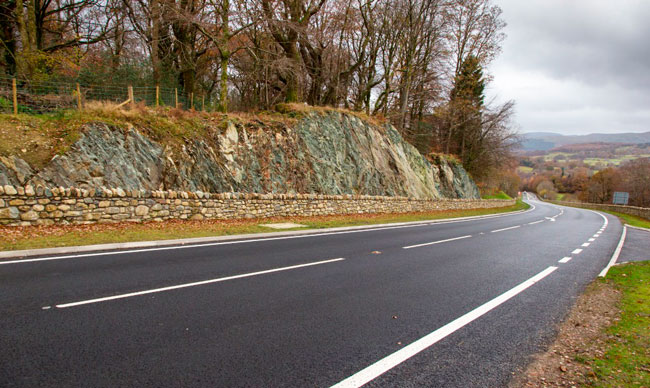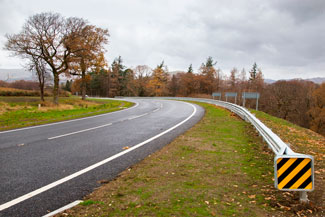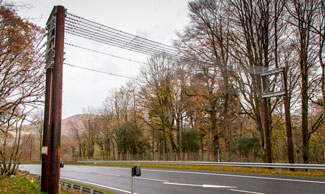A470(T) Maes yr Helmau to Cross Foxes ImprovementWhole Project Award |
|
Project Team
Client: Welsh Government
Designer: YGC
Contractor: Alun Griffiths Contractors Ltd
-------------------------------------------------------------------------------------------------------------------------------------------------------------------------------------
Project summary
The A470(T) Cross Foxes to Maes yr Helmau Improvement is situated approximately 2.5km east of Dolgellau, Gwynedd (from SH 754 184 to SH 765 167), between a previously improved section to the north and the junction with the A487 to the south. The previous section of road was narrow (around 5.5m minimum) with no verges, tight bends and limited visibility. The scheme objectives were therefore to:
• Reduce accidents and casualties
• Improve journey times
• Maximise reliability.
The new road is 7.3m wide with 1.0m hard strip southbound and 0.6m northbound, and minimum 2.0m grass verge. For environmental reasons, there were also departures and relaxations in horizontal alignment and visibility.

The improvement is notable for the environmental sensitivity of the area within which it lies – not only the Snowdonia National Park, but also a Site of Special Scientific Interest and a Special Area of Conservation designated under European legislation.
Challenges faced and Achievements
Ecology and Biodiversity
| This scheme represents a step forward in the assessment of infrastructure projects’ effects on environmentally sensitive sites, and their successful mitigation. It was assessed as affecting the qualifying features of the Meirionnydd Oakwoods and Bat Sites Special Area of Conservation (SAC, designated under the European Union’s Habitats Directive) and therefore underwent Assessment of Impacts Upon a European Site (AIES) to demonstrate ‘Imperative Reasons of Overriding Public Interest’ and consequent ‘Compensatory Measures’. |
|
The ecological sensitivities necessitated a different approach. There was close consultation with Countryside Council for Wales (CCW, now Natural Resources Wales) and other statutory environmental bodies throughout scheme development. To demonstrate how the environmental impact, with particular regard to the SAC features, had been minimised, the designers produced options that varied the alignment of the route in 10m increments, for discussion with CCW before adopting the final alignment. Mitigation measures introduced to minimise impacts upon foraging lesser horseshoe bats involved a combination of oversized culverts (2.7m diameter), low level lighting, an aerial crossing structure and tree canopy retention.
These measures haven’t been tried in combination before – bollard lighting elsewhere is directed away from the road, whereas these lights illuminate the highway, minimising light spill into the woodland and ensuring bats aren’t deterred from using the culvert.
Other ecological mitigation measures introduced into the design included:
• phase site clearance to avoid impact upon a known dormouse population;
• a dormouse crossing structure beneath the carriageway;
• protection of lichens and host trees, and lichen translocation where tree removal was unavoidable;
• otter ledges, ramps and fences around culverts;
• protection of a birch tree hosting Welsh Clearwing moths;
• sowing of seed within the highway soft estate using a wildflower mix harvested from fields adjacent to the site
• use of steepened earthwork solutions to prevent impact upon significant trees or valuable habitat adjacent to the works.
Physical Resources Use and Management
Various measures were adopted to minimise the project's direct and in-direct impacts upon natural resources. At tender the scheme involved disposal of 5,000m3 of material, but during construction it was possible to deposit most of this in sections of surplus land between the old and new carriageways, making the land suitable for returning to agriculture and blending into the landscape, rather than retention by the highway authority as earthworks slopes. The extended earthworks provided an opportunity to bury on site Japanese knotweed infested soils excavated during the works rather than disposing at landfill, and also had the added benefit of improving the situation in terms of bat foraging areas after completion.

Carefully excavated rock face, and wall constructed with stone recovered from within the site
Boulders from rock excavation/blasting were used for EA flood protection works. All walling stone was obtained within the site, by re-using stone from existing walls, or selection from excavated/blasted material. The sustainable merit of different designs, materials and construction methods were considered for all structures incorporated into the works. Low energy consuming lanterns were selected to provide carriageway illumination for bat mitigation purposes.
People and Communities
Consideration of the local community and local stakeholder groups was fundemental to the development of the improvement from the outset. During scheme preparation, a stakeholder workshop was held following the principals of the Welsh Transport Appraisal Guidance (WelTAG), to ensure the scheme met the needs of the local population and the travelling public. This highlighted problems that buses experienced at the B4416 junction and the benefits the scheme would bring. Following publication of draft Orders, the scheme was further modified to address concerns expressed locally.
A public relations exercise prior to the commencement of works included:
• Meeting non-statutory environmental groups;
• Pre-start meeting with county councillors and community councils;
• Public exhibition in Brithdir.
During construction the project team engaged with the local community through:
• Regular Councillor Liaison Meetings to update on progress and plans;
• Newsletter detailing progress and plans;
• Presentation and interactive sessions with children from Brithdir Primary school;
• Institution of Civil Engineers Bridges to Schools event at Dinas Mawddwy village hall;
• Donation of 40t of topsoil to the local college to assist Independent Living Skills students who were growing vegetables for sale at local markets;
• Talks to local interest groups.
To what extent did the use of CEEQUAL influence your project?
 |
Environment and sustainability were very much headline issues for the scheme due to the sensitivity of the scheme corridor. The use of CEEQUAL further emphasised and structured the project approach to sustainability, and encouraged the project team to consider the opportunities and/or implications associated with different design and construction options throughout the duration of the contract. Alun Griffiths Contractors also aligned their Construction Environmental Management Plan with the different sections of the CEEQUAL Assessment Manual. |


